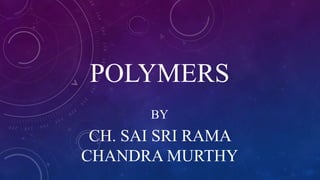
Polymers
- 1. POLYMERS BY CH. SAI SRI RAMA CHANDRA MURTHY
- 2. Introduction: Polymers are large molecules composed of repeated chemical units. The smallest repeating unit is called monomer (mono [Single] + mer [part]). The word polymer is derived from the Greek word „poly‟ = many; mers = parts. It is generally described in terms of single repeated units such as CH2 = CH2 –(CH2 – CH2)–n Ethylene Polyethylene Definition: Polymer is a macromolecule built-up by linking together of a large number of smaller molecules called monomers. Eg: Polyethylene is a polymer formed by linking together of a large number of ethylene molecules.
- 3. The process by which the simple molecules (monomers) are converted into polymers is called “polymerization”.
- 4. Degree of polymerization: The number of repeating units (n) in a polymer chain is called degree of polymerization (DP). Eg: If 100 molecules of ethylene polymerize to give the polymer chain, the DP of ethylene is 100. All polymers are macromolecules but all macromolecules are not polymers because polymer consist repeating units of monomers. Eg: Chlorophyll is a macromolecule but not polymer. Types of polymers Based on the source of polymers, there are two types of polymers namely natural polymers and synthetic polymers.
- 5. a.) Natural polymers: The polymers which are obtained from natural sources such as plants and animals are called natural polymers. Plant polymers: Ex: Cellulose – flexible, strong natural polymer, gives shape to plant cells. It is made in the plant when sugar molecules are joined into long strands. Animal polymers: Ex: Spider web – chemicals in the spiders body mix to make the spider web; one of the strongest materials known. Silk – polymer made from the silkworm. These two types can be Wool – polymer made from the wool of sheep. woven into thread and cloth. Our body also has polymers. Finger nails – made from proteins which are polymers. Amino acids – makes up proteins (act as monomers)
- 6. b.) Synthetic polymers: The polymers which are synthesized from simple molecules are called synthetic polymers. Most polymers used in everyday activity are synthetic and starting material for most of these come from coal or oil (petroleum products). These polymers are used due to a lower cost to produce, longer durability, flexible, strong, hard and light weight. Eg: • Plastic is a synthetic polymer that can be molded or shaped. • Polyester and nylon are used more instead of cotton, wool, silk, etc. • Laminated counters and vinyl floors are used in kitchens instead of pure wood. • CDs, computer parts, artificial heart valves, tires, all come from polymers. • Other examples are – strong polymers when paired with light weight ones can be used in airplanes, bikes, cars, fishing rods, sports equipment, etc.
- 7. Types or Methods of polymerization The conversion of a monomer into a polymer is an exothermic process and if heat is not dissipated or properly controlled, explosions may take place. The polymerization reactions are broadly classified into three types. 1. Addition polymerization or Chain polymerization 2. Condensation polymerization or Step growth polymerization and 3. Copolymerization.
- 8. Eg: 1. Addition or Chain polymerization: The polymerization that takes place by self addition of the monomer molecules to each other through a chain reaction is called addition polymerization. • No by-products like H2O, CH3OH etc. are produced. • The polymer has the same chemical composition as that of monomer. • The molecular weight of the polymer is the exact multiple of the monomers. • An initiator is required to start the polymerization reaction.
- 9. 2. Condensation or Step polymerization: Step polymerization takes place by condensation reactions of functional groups of the monomers and elimination of small molecules like water, HCl, etc. • The monomers contain functional groups like -OH, -COOH, -NH2, halides, etc. The polymer is built up by a slow stepwise condensation of the functional groups of the monomer. • The polymers produced are living polymers containing functional groups at the end of the chain. • The reactions are catalyzed by catalysts. Eg: Polymerization of a diamine with diacid gives nylon 6,6 (polyamide)
- 10. Condensation or Step polymerization
- 11. 3. Copolymerization: It is the joint polymerization of two or more species. High molecular weight compounds obtained by copolymerization are called copolymers. Eg: Butadiene and styrene copolymerize to yield GRS rubber (Styrene- butadiene rubber). Dif
- 12. Differences between Addition and Condensation polymerization Addition polymerization Condensation polymerization 1. Repeat units and monomers are same. 1. Repeat units and monomers are different. 2. Polymerization involves no loss of molecules or atoms. 2. Polymerization is accompanied by loss of molecules or atoms. 3. Monomer concentration decreases steadily. 3. Almost all the monomer disappears in the first 10% of the reaction. 4. All the polymer is formed at once and molecular weight of the polymer changes little throughout. 4. Molecular weight of the polymer rises throughout reaction. 5. High molecular weight polymers are formed all at once. 5. Low molecular weight polymers are formed. Longer reaction times are essential for obtaining high molecular weight polymers. 6. Mainly homochain polymers often have carbon chains. 6. Mainly heterochain polymers often have functional group atoms as a part of chain. 7. Monomer could be mono functional. 7. Monomer needs to be bi- or poly- functional.
- 13. THANK YOU
